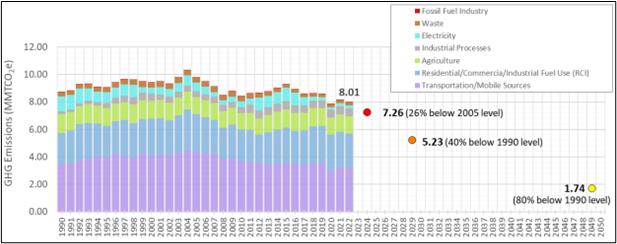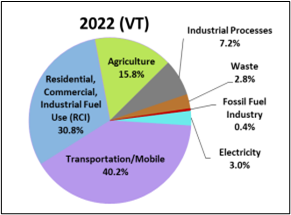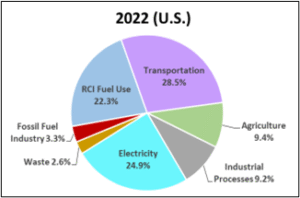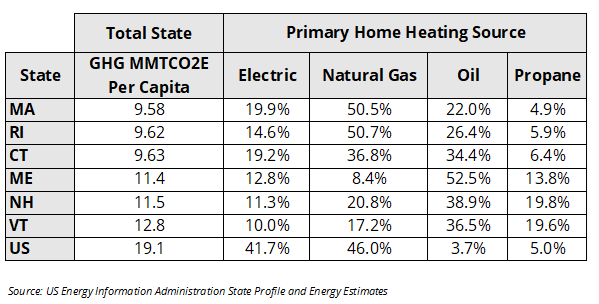September 2, 2025
VT GHG Reduction Mandates Remain Expensive, Elusive
In August 2025, the Vermont Agency of Natural Resources released the state’s updated Greenhouse Gas (GHG) Inventory and Forecast, which catalogs GHG emissions in Vermont. The new report covers the period from 1990 through 2022.
For 2022, ANR found that GHG emissions totaled 8.01 MMTCO2e (million metric tons of carbon dioxide equivalent). This represents a 2% decline from 2021 and is the lowest level recorded outside the first year of the COVID-19 pandemic (2020).

Source: ANR Greenhouse Gas Inventory and Forecast (2025)
Recent Emissions History. Vermont’s GHG emissions reached a peak of 9.81 MMTCO2e in 2005 before declining through 2010. As the state and national economies exited the Great Recession, emissions increased through 2014 when they reached a peak of 9.31 MMTCO2e.
Since then, GHG emissions have declined steadily if inconsistently. The pandemic social and economic restrictions show the depth of disruption necessary to achieve significant short-term GHG reductions without significant advances in cost-effective emissions control and alternative technology.
Vermont vs. US. The report also compares the sources of Vermont’s GHG emissions to the country as a whole:


Unsurprisingly, Vermont’s electricity sector accounts for a significantly smaller share of GHG emissions than the national average. Vermont has no utility-scale fossil fuel electric generating plants and in-state generation is 100% renewable. This does not count electricity supplied through ISO-New England, the regional grid operator, which relies on natural gas electric generation for ~55% of its supply.
Similarly, due to a colder than average climate and rural population, transportation and building heat account for greater shares of emission than the national average.
More Mandates = More Expensive Energy. As outlined in the report, Vermont must meet increasingly stringent GHG reduction mandates under the 2020 Global Warming Solutions Act (GWSA). Emissions must not exceed the following levels:
January 1, 2025: 7.26 MMTCO2e (data will not be finalized until 2028)
January 1, 2030: 5.23 MMTCO2e
January 1, 2050: 1.74 MMTCO2e
The full cost of meeting these mandates has never been identified but will total billions of dollars. While the Vermont Legislature has never adopted a plan to meet the ill-conceived mandates they forced on the state five years ago, the GWSA allows private lawsuits to enforce the law. This puts unaccountable lawyers and activist judges in charge of critical decisions about the state’s economic future.
Unless the GWSA mandates are modified or repealed, the bulk of this cost will be borne by Vermonters in the form of much higher energy prices and higher taxes.
Policy Considerations. Vermont policymakers need to weigh the near- and long-term economic impact of their mandates and consider how regional and global energy trends will exacerbate the energy affordability problem.
Policymakers must remember that GHG emissions are a global problem, not one that can be solved locally. In 2022, Vermont accounted for just 0.016% of global GHG emissions.
According to author Robert Bryce, the US’s share of global CO2 emissions in the United States declined by nearly 50% from 2000 (24%) to 2024 (13%), while the combined share of India and China more than doubled (18% to 40%). This is driven, in part, by a nearly six-fold increase in coal-fired power generation in China. Coal-fired power declined by two thirds in the US during the same period.
Vermont has no coal-fired power generation and last two plants in New England will close by 2028.
Vermont’s per capita GHG emissions are one third less than the national average and the Vermont Department of Health (VDH) reports that the state’s air quality is “very good.”

In Vermont, ground-level ozone and particulate matter emissions – air pollution that can be mitigated locally – declined substantially between 2000 and 2020.
In addition to Vermont’s expensive GHG reduction mandates, massive growth in power hungry data centers and electrification of cars, trucks, heating, and industrial processes will require hundreds of billions in new and upgraded power generation, transmission and distribution infrastructure.
The combined impact will put enormous economic pressure on Vermont workers and small business owners.
NFIB is a member-driven organization advocating on behalf of small and independent businesses nationwide.
Related Articles














